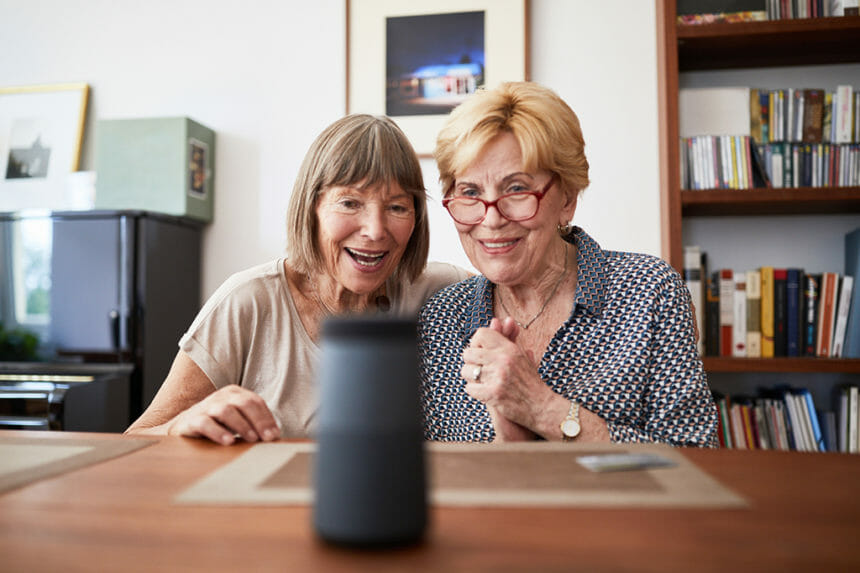In the most recent Big Tech foray into digital healthcare, Amazon and Teladoc Health announced they will be partnering on a program to provide virtual medical care. Users of Amazon’s Alexa-enabled devices will now be able to contact a doctor via voice command.
The virtual visits, which will initially be voice-only, will allow patients to speak with a doctor about non-emergency conditions on a 24/7 basis. That includes everything from the flu and COVID-19 to allergies and infections.
Once customers place the request with Alexa, the device will connect with the Teladoc call center. From there, a board-certified doctor will be available to discuss general medical needs with them.
“Our goal with this launch is to make healthcare access even easier for customers – getting started by simply saying, ‘Alexa, I want to talk to a doctor,’” said Chris Savarese, director of corporate PR at Teladoc.
The partnership is part of a broad push by the tech industry into telehealth and digital healthcare. Amazon, Apple and Google are all seeking to extend their influence deeper into the healthcare realm.
Partnering with Teladoc was a “logical play” for Amazon, said Scott Snyder, chief digital officer at Eversana. But “the doctor visit itself is not where Amazon’s value is going to be created,” he stressed.
“It’s more about getting more touch points out there and getting more people engaging with Alexa and buying Alexa-driven devices,” Snyder explained. “On the back end, it would benefit Amazon’s pharmacy and even retail operations. The products or prescription medications that could get pulled by Alexa telehealth visits are very interesting to Amazon.”
Given Teladoc’s set network of clinicians, the partnership should also allow Amazon to dive deeper into medical care than it’s currently doing with Amazon Care, which was created to accommodate more urgent health situations.
“Teladoc goes deeper into chronic care and they manage chronic disease,” Snyder noted. “They can provide deeper care alternatives for patients. It’s a good alternative, and it also keeps the pace for where the market’s going, because there’s lots of competition out there.”
Google’s partnership with Amwell rolled out in 2020. It allowed Amwell to take advantage of Google Cloud as well as AI and machine learning technologies to enhance the healthcare experience.
So far, the results have been promising for all parties involved. Teladoc and Amwell recently reported increases in their 2021 revenue.
Other players include Verizon, which offers an integration with Apple Health allowing patients to share health data with providers during virtual visits. Insurers and payers are also active on the tech front, with Cigna snapping up MDLive.
“There’s a lot of different variations out there,” Snyder noted.
Still, some experts caution that privacy and security concerns won’t be easily dismissed.
“Alexa is HIPAA-compliant as a platform, so that’s reassuring. But a lot of people could potentially be hesitant due to privacy,” said Mark Pappas, SVP of innovation at CMI Media Group.
And while telehealth has largely been lauded as a solution to healthcare access problems in marginalized communities and rural areas, not everyone can afford an Alexa-enabled device. Partnerships like the Amazon/Teledoc one, then, may ultimately fail to connect hard-to-reach areas with virtual care, noted Cynthia Miller, VP and medical director of PrecisionValue’s access experience team.
“It might increase access with certain income groups, but not necessarily for low-income groups,” she said. “You also have to have broadband internet. There are a lot of areas where broadband isn’t available, so for those populations this will have limited utility.”
Miller added, however, that the more telehealth expands now, the more it can be used to support medical care beyond the COVID-19 pandemic – and even during future crises related to climate change and natural disasters.
“What the pandemic has really highlighted is that telehealth increases our capacity to have access to physicians nationally that you can bring in to support an area,” Miller said.
Snyder expects the current growth to continue in the years ahead. He characterizes partnerships of this nature as an “overall positive” for the healthcare industry.
“It’s great as long as technology companies go in with the right intent and are patient-centric, and work with the established providers and in some cases even pharma companies,” he said. “You have people who understand how to engage consumers day-to-day on their terms, and you couple that with the expertise of delivering care and medications to people. It’s the best of both worlds.”







